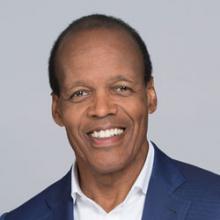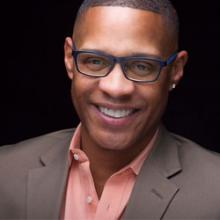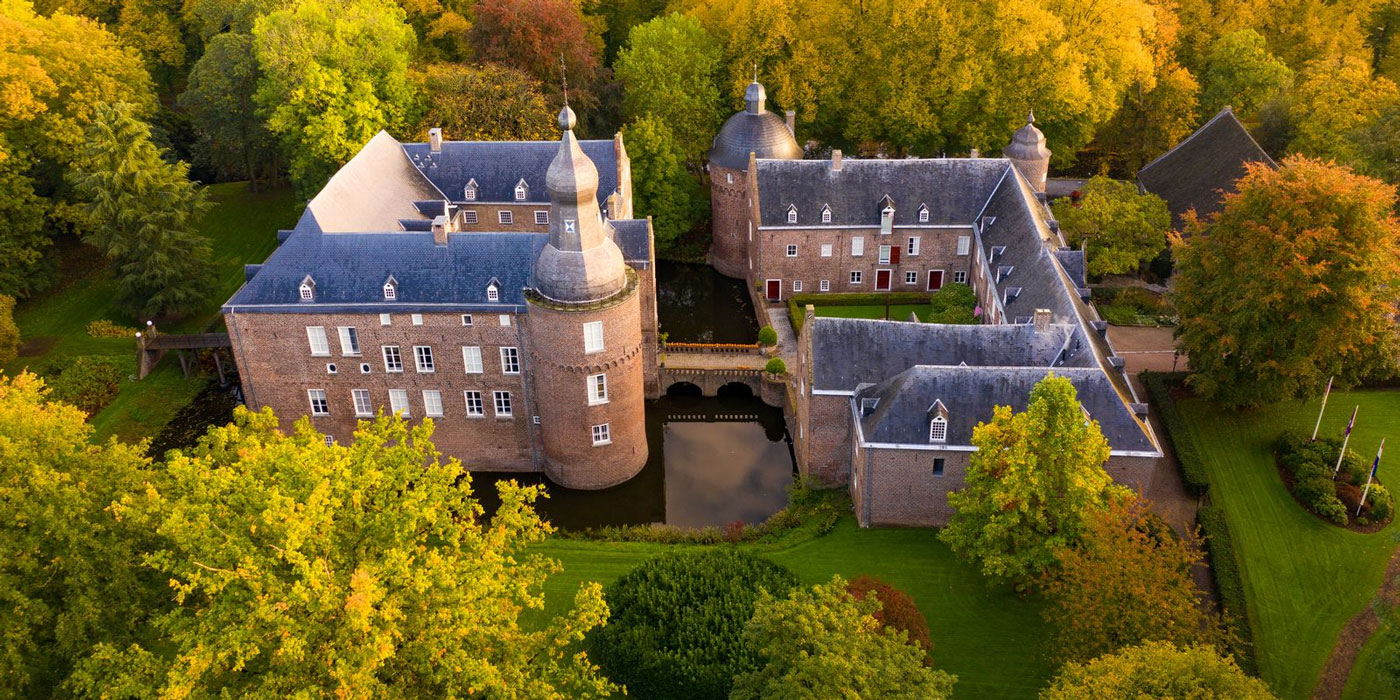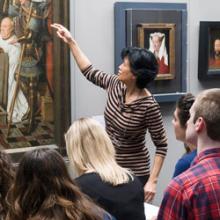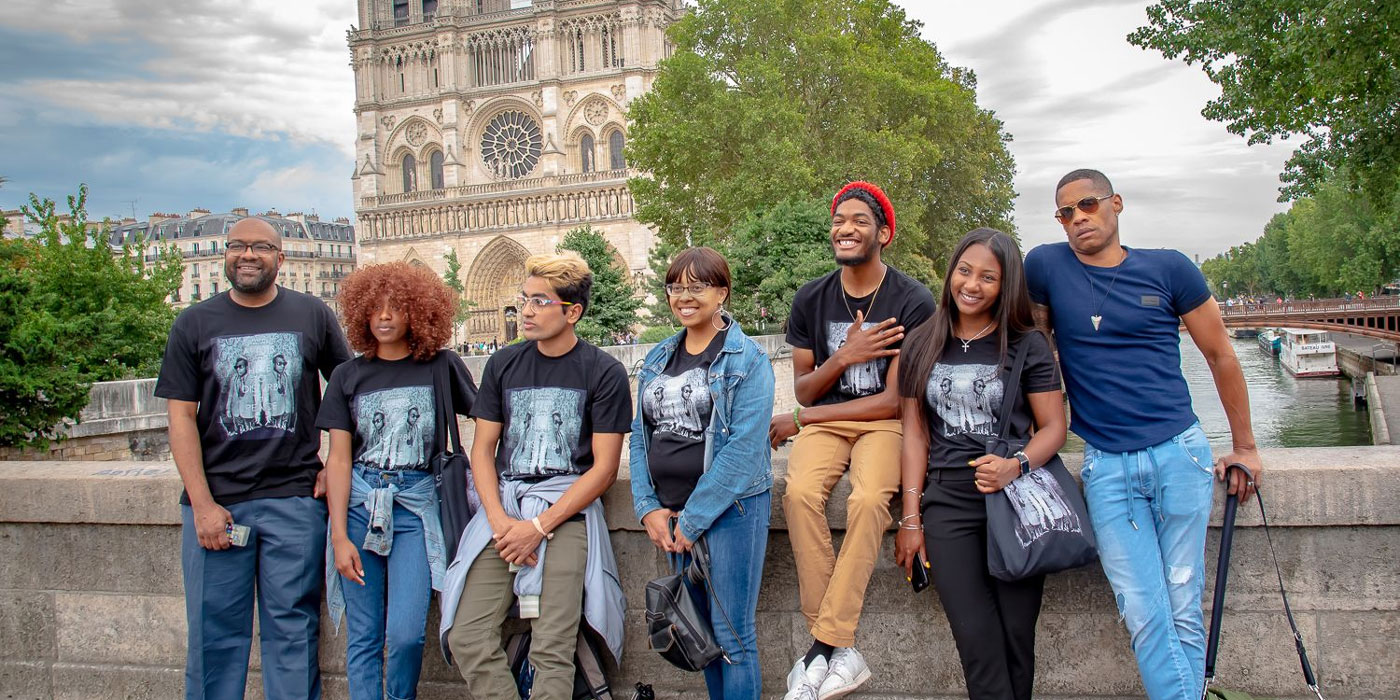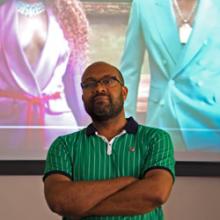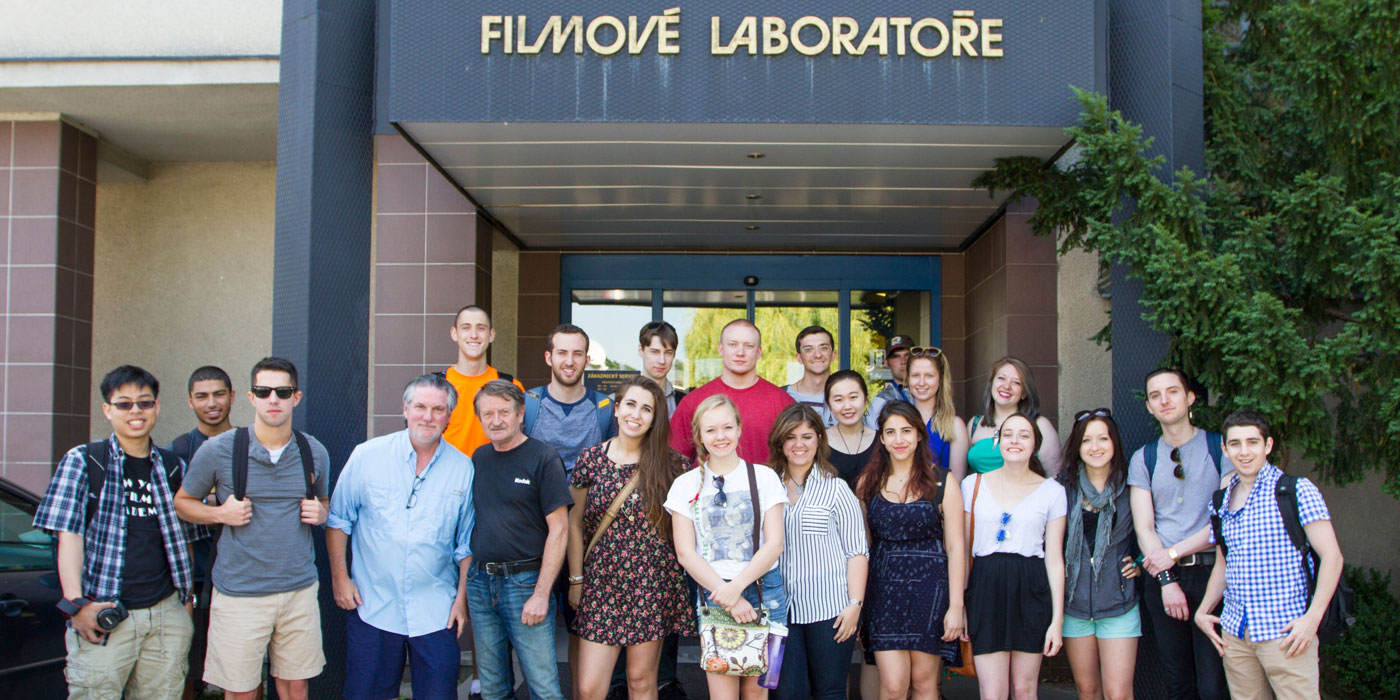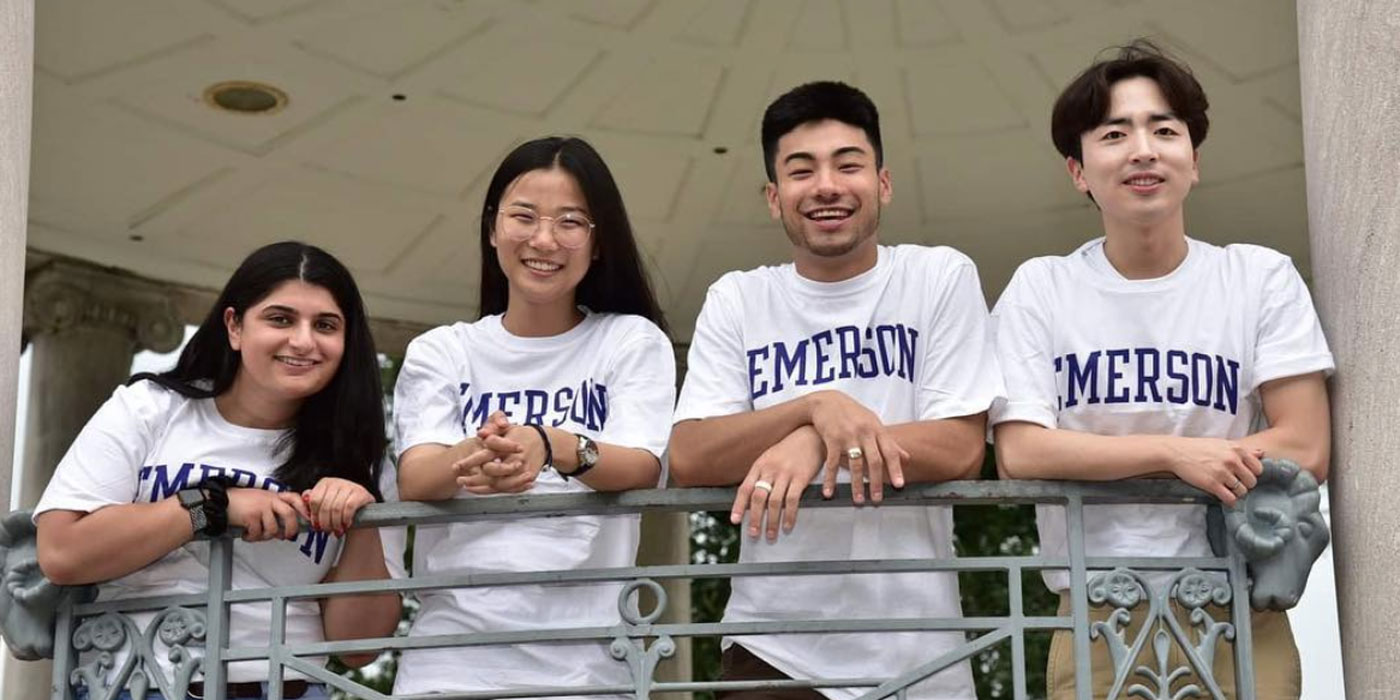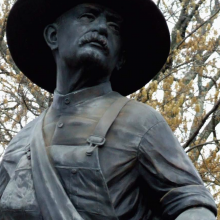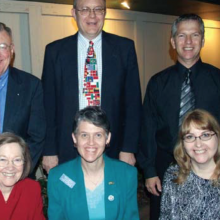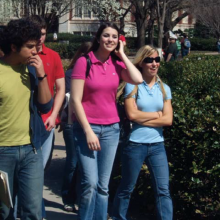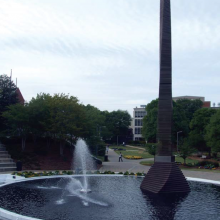Relationship Cultivation
Creating Inclusive Practices for International Students and Scholars to Enhance Wellbeing
2020 Comprehensive Emerson College
From a Mandarin Chinese theater group in Boston to a fourteenth-century castle in the Netherlands, Emerson College’s creative and academic reach spans the globe. A robust portfolio of study abroad programs, global partnerships with arts institutions around the world, and a supportive environment for its growing international student population help the college bolster its goal of becoming a top institution of higher education for arts and communication.
“Internationalization is really essential to being a leader in arts and communication,” says Michaele Whelan, PhD, provost and vice president for academic affairs. “And it’s very pivotal for us to establish global networks of artists and professionals so that we can enhance our students’ capacity to learn and thrive in the world.”
Founded as a school of oratory and dramatic arts in 1880, Emerson College now offers nearly 40 degree and professional training programs in fields such as acting, business of creative enterprises, film, journalism, public relations, and stage production. Approximately 4,000 undergraduate and 600 graduate students study at its main campus on Boston Common in the heart of the city’s Theater District.
The college hosts more than 500 international undergraduate and 115 international graduate students from 71 countries and offers global bachelor’s degrees with partner institutions in France and Switzerland. Students can spend a semester taking classes and participating in internships at the college’s second U.S. campus in Los Angeles or study abroad at Kasteel Well, a medieval castle in the Netherlands.
When President Lee Pelton, PhD, came to Emerson in 2011, he identified internationalization and global engagement as one of five strategic priorities, along with academic excellence, civic engagement, innovation, and financial strength. “It’s clear that engaging with different cultures, heritages, backgrounds, and perspectives enlarges our intellectual horizons and connects us with life’s most enduring themes,” Pelton says.
Leading Internationalization at the Institutional Level
Pelton’s goal was for Emerson College to become a truly global institution. “In order to bring a big idea to life, you need three things: resources, strategy, and leadership,” he says.
In 2014, Anthony Pinder, PhD, was brought on as the associate vice president of internationalization and global engagement. “I arrived as the inaugural senior international officer [SIO] at Emerson,” Pinder says. “A lot of what was happening before I came was really random acts of internationalization.”
Pinder says that Pelton gave him free rein to develop his own vision for internationalization. Pinder has previously served as SIO at four other institutions and says, “Never have I been so empowered.”
One of the first things that Pinder did was conduct a needs assessment and convene various working groups and committees to produce reports that fed into a new strategic plan for internationalization. That led to the creation of a central unit that oversees education abroad, the Netherlands and Los Angeles campuses, and international student affairs.
“We began centralizing all of the international entities, departments, and initiatives under this new Office of Internationalization and Global Engagement [IGE],” Pinder says.
IGE has also appointed a chief diversity officer whose role it is to reach out to diverse and underrepresented students and seek to address any barriers they may face when considering education abroad.
David Griffin, MA, director of education abroad and domestic programs, has been a staff member at Emerson for 34 years. “The transformation has been somewhat breathtaking,” he says.
Previous administrations had been supportive of the Kasteel Well program in the Netherlands but had not been driving comprehensive internationalization. “Without institutional support from the top, [it is] very difficult to make dramatic change,” Griffin says. “President Pelton put it front and center, and everything has really flowed from that.”
Making Internationalization Relevant to the Arts
Whelan says that students who enroll at Emerson typically already know what they want to study, making targeted internationalization efforts particularly important. “For students who are very focused professionally, internationalization has to be relevant to them,” she says. “We are not a typical liberal arts institution in which students come and discover what their major is.”
Students choose Emerson because of the specialized professional curriculum and faculty the college offers. Therefore, it is often necessary to make a case for why internationalization matters in their careers as artists or communicators.
For instance, Emerson faced challenges in getting students in some disciplines, such as the visual arts, to participate in education abroad. To increase awareness of international opportunities, campus leaders invited student winners of Emerson’s film festival to submit entries to an international film festival hosted at Hong Kong Baptist University, which offers an exchange program in journalism and film. Students then traveled with faculty to take part in the festival in Hong Kong.
As a result of this experience, students began to realize the benefit of developing a network of artists from around the world. “All of a sudden, that’s relevant,” Whelan says.
Rethinking Partnerships and Portals
When Pinder was hired in 2014, he began to review the college’s portfolio of partnerships with the goal of ensuring that all students have the same access to global opportunities. “I spent my first year being very diplomatic and pulling Emerson out of several relationships,” he says. “And then we spent a lot of time really thinking about what types of institutions added value to our academic operation.”
Pinder tries to find partners that have complementary but unique program offerings. “We’ve partnered with some of the leading institutions in the various disciplines related to arts and communications in the world,” Pinder says.
One example is a partnership with Blanquerna, a school within Universitat Ramon Llull in Barcelona, Spain, which has one of the top-ranked communications programs in the country. Emerson students can spend a semester in Barcelona studying international communication, international relations, journalism, advertising and public relations, cinema and television, and Spanish.
Emerson has also recently started developing relationships with other institutions abroad that allow it to expand its global footprint through joint-degree programs known as portals. “These are ways in which both Emerson students, but also international students, can receive an Emerson education whether they’re physically in Boston or not,” says Corey Blackmar, MA, associate director of internationalization initiatives.
Emerson has recently launched a portal program in collaboration with the Paris College of Art that culminates in a bachelor of fine arts in film arts. Students spend 2 academic years in France, 2 summers in Boston, and 1 summer at Kasteel Well in the Netherlands.
In another new portal program, students earn an international and political communications degree with Franklin University Switzerland in Lugano. Students can do a 2+2 program, in which they complete their first 2 years in Lugano and their second 2 years in the United States, or a 3+1 program, in which they spend their senior year at Emerson followed by a master’s degree.
In its strategic plan, IGE aims to have 60 percent of students participate in at least one education abroad experience during their time at Emerson.
Proposing International Curricula
Using money from the Presidential Fund for Curricular Innovation, Pinder oversees the Curriculum Internationalization Studio, which provides grants to faculty to infuse global content into an existing course or develop a new course with an international focus.
Faculty turn in grant proposals that are reviewed by a committee made up of three deans and the department chairs of the faculty submitting the proposal. Pinder says it has been an excellent way to involve academic leadership from across the institution in efforts to internationalize the curriculum. “Not only has the grant been a wonderful opportunity for the faculty, it’s also obviously been a wonderful opportunity for reaching these different academic departments,” he says.
The awardees receive a stipend and participate in a series of professional development workshops on topics such as aligning student learning outcomes. They also are awarded funding for travel or other external training that will enhance their curriculum design. Pelton has allocated a total of $40,000 to the Studio per year.
In total, more than 50 faculty have participated in the Studio, developing 27 new courses with significant international content. Faculty have revamped existing courses in Africana studies, global media, journalism, marketing communication, and other subjects. For example, two screenwriting courses (one production-based and one studies-based) were revised to be faculty-led programs in Patmos, Greece. Students workshop their scripts on site, infusing what they learn from being exposed to Greek culture. The students learn to alter scripts and ideas on the go and incorporate multiple perspectives in their work.
A welcome byproduct of the success of the Studio has been the rapidly growing portfolio of faculty-led education abroad programs—known as Global Pathways Programs—which has expanded from 1 in 2013 to 23 that would have run in 2019–20 if study abroad had not been suspended due to COVID-19. Faculty-led courses developed through the Studio include programs in Canada, Cuba, Ecuador, Ghana, Greece, Japan, the Netherlands, South Africa, and the United Kingdom.
Living And Learning at Kasteel Well
Emerson’s flagship study abroad experience is the semester-long program that runs at Kasteel Well, a fourteenth-century castle in the Netherlands that the college purchased in 1988. “The opportunity to own this castle and be a part of refurbishing a national treasure became a dual civic engagement project and one of our signature education abroad programs,” Pinder says.
At the Kasteel Well campus, eight student affairs staff oversee student services, such as programming, housing, health and wellness, and counseling. They also take students on multiday field trips to Amsterdam and other European capitals. “We play the same role as a student affairs division on any campus in the United States,” says Tikesha Morgan, MA, senior student affairs officer.
Emerson aims to have students from every major represented on the Kasteel Well program, which can accommodate up to 90 students per semester. The program is designed for second-year students and taught by local Dutch and other European faculty. During the summer, the castle also hosts several faculty-led programs.
Dulcia Meijers, PhD, executive director of Kasteel Well, is a Dutch architectural historian. She was able to petition the Dutch government to declare Kasteel Well a national historic landmark, thus providing some government funding to assist with its upkeep.
Madison Wilson, a film and TV production major, studied at Kasteel Well in spring 2019. “It was such a surreal experience because most of the castle is still preserved in its original architecture,” she says.
Studying African American Literature in the Netherlands
The James Baldwin Writers’ Colony is one of the many faculty-led Global Pathways Programs hosted every summer at Kasteel Well.
Associate professor and cultural critic Jabari Asim developed the curriculum for a course focused on the writing of James Baldwin, an African American novelist who settled in Europe in 1948, and other expatriate writers. He worked with Pinder through the Curriculum Internationalization Studio to design the course.
Asim says he was initially unsure how to lead a study abroad program focused on African American literature. “I hadn't expanded my imagination to see how my particular discipline would work in that context,” he says.
The program, which was first offered in 2018, consists of a combination of fiction and nonfiction writing workshops and lectures on the Black expatriate literary tradition. According to Asim, there is a long history of African American artists, musicians, and writers who traveled to Europe, predating the Civil War.
In addition to spending time in the Netherlands, the group travels to Paris and Amsterdam, where they visit sites and restaurants that were frequented by writers, such as Baldwin and Richard Wright.
“We get right into the craft of writing almost immediately, but because of the subject matter, it’s really necessary to immerse the students in the tradition,” Asim says. “Hopefully their idea of African American literature and culture is vastly expanded once they begin to see it as a global phenomenon.”
The program was created with the goal of attracting more students of color to education abroad. Half of the students on the program are recruited from five historically Black colleges and universities.
“[The program] was established as an intentional effort to underscore our college’s strategic priority of inclusive excellence,” Pinder says.
Jae Suk Lee, a journalism major from South Korea, was the only international student who joined the program in summer 2019. He was particularly captivated by Baldwin’s essay “A Stranger in the Village.” “He really described this idea of being exotic and being foreign,” Lee says. “That really helped me grasp how racism works in different countries, even to the point where it’s happening right now—even with the coronavirus and the Asian American community. That’s definitely helped me understand the depth of it and how racism is still there.”
He says the program has helped him understand the Black Lives Matter protests in the United States, following the murder of George Floyd by police officers in Minneapolis. “We learned how Black artists [and other artists of color] have fought for justice and have continued to do so,” he says. “I have felt from the bottom of my heart how empowering words can be and how literature and arts bring a call to action.”
Filmmaking in Prague
James Lane, PhD, senior scholar-in-residence and graduate program director of the low-residency master of fine arts in writing for film and television, developed Emerson’s first faculty-led summer program. He has taken film students to Prague, Czech Republic, to spend 4 weeks at the Film and TV School of the Academy of Performing Arts (FAMU) every summer since 1996. Summer 2020 was the first time the program has not run since inception.
In addition to a class on the history of Czech and Slovak cinema taught by a local professor, Emerson students take Lane’s film production course. Two Emerson students work together to produce a five- to seven-minute movie set somewhere in Prague. They are partnered with a Czech student studying production at FAMU and cast local actors.
“The city itself to some extent becomes the classroom,” Lane says. “We force [students] to find locations all over the city to shoot their films. When they get there, they’re going to be totally disoriented. And by the time they leave...the students really do get to know the city very well.”
During the program, Lane takes students to local theaters and Barrandov Studios, one of the largest film studios in Europe, where they are able to explore the costume and prop departments. They then spend a few days at the Karlovy Vary International Film Festival, held annually approximately 80 miles from Prague. Finally, students visit historical sites, such as Terezin, a Jewish ghetto and concentration camp established by the Nazis during World War II.
Alexis Brankovic is an aspiring film director and writer who graduated from Emerson in May 2020 with a bachelor of fine arts in visual and media arts. She studied in Prague in summer 2018. Together with her roommate, she produced a short film about a young painter who wanted to get out of his hometown to see the world.
“The Prague program was a perfect whirlwind of studying and exploring the city,” Brankovic says. “As a filmmaker, I realized the film industry is so much bigger than Hollywood.”
Supporting International Students
From 2010 to 2019, Emerson has more than tripled its international undergraduate population. The number has grown even more rapidly in recent years, with a 47 percent increase since 2017. Last year, international students made up 13 percent of incoming students.
Andrea Popa, MA, joined the IGE staff as director of the Office of International Student Affairs in December 2018. She came to Emerson shortly after the college had seen a huge upswing in international student enrollment. Popa’s team works closely with other units, such as the writing center, housing, student affairs, and the career center. Part of her job is to build a sense of community for the burgeoning international student population through academic support, campus integration, and career preparedness.
“As somebody coming in new with the sort of surge of new international students we had, I really saw the college step up its game in a way that was significant,” Popa says. “I saw folks in all these other offices really come up with a strategy to be able to serve the international student community.”
For example, Jeremy Heflin, MA, associate director of English language learning (ELL) initiatives, has developed an English language assessment that helps place students who need extra support into ELL classes.
The support that Emerson provides its more than 600 international students continued as colleges around the country shut down their physical campuses due to COVID-19. Popa says that her office switched to remote advising when Emerson classes moved online in mid-March. The college kept dorms open for international students who were unable to travel and repurposed some funding to help with unexpected costs, such as plane tickets home or laptops for remote schoolwork.
Lee, the journalism major from South Korea, says that he has seen major changes in the composition of the student body since he first enrolled at Emerson in 2015. “I remember the feeling of being foreign and exotic when I first came here,” he says. “But now I see so many people that are international, and we’re moving forward with having more diversity in this institution.”
International Alumni Communities Can Help Through Uncertainty
Call In the Cavalry: How Alumni Can Support International Student Recruitment
Strategies for International Student and Scholar Advising
Collaborative Approaches to Developing Faculty-Led Programs
2007 Comprehensive University of Oklahoma
A stranger visiting the University of Oklahoma’s graceful campus in Norman, Oklahoma, who drives down David L. Boren Boulevard, or strolls into the David L. Boren Honors College, or spies the statue of David Boren in a cornice on Evans Hall might assume that Boren led the university during its glory days.
He did—and still does. For the University of Oklahoma, these past 13 years since David L. Boren relinquished a powerful seat in the U.S. Senate to lead his alma mater are the glory days. In writing a new chapter in a life of public service, Boren has presided over a period of dramatic growth and growing confidence for the University of Oklahoma. Sooners have always taken kindly to Boren, the former Rhodes Scholar and politician. They elected him governor at age 33 in a near landslide in 1974, and he won his last Senate race in 1990 with 83 percent of the vote. On his watch OU has quadrupled the number of endowed professor chairs, raised more than $1 billion, and erected dozens of new academic facilities. Even the powerful football team has added a seventh national championship to its trophy case. (A predecessor, George Lynn Cross, once quipped that he wanted to build a university of which the football team could be proud.)
Befitting a former chair of the Senate Select Committee on Intelligence and a man for whom a federal study abroad scholarship is named, Boren has given international education pride of place in OU’s curriculum and activities and made the Norman campus a regular stop for world leaders from Margaret Thatcher to Mikhail Gorbachev. Soon after taking office in 2006 as Africa’s first elected female head of state, Liberia’s President Ellen Johnson-Sirleaf visited at the invitation of Boren and Ambassador Edward J. Perkins, OU’s senior vice provost for international programs and former U.S. ambassador to Liberia, South Africa, and Australia.
Spurt in International Studies
Oklahoma has boosted study abroad by providing $250,000 in international travel grants and fellowships for students and faculty; three-quarters goes to students. OU has added 15 faculty positions in Chinese and Arabic languages, Asian philosophy, history and politics, the economics of development, European security and integration, international business management, and other disciplines. The School of International and Area Studies, launched in 2001, has grown from three dozen to 350 majors. “It is a hard-charging group,” said political scientist Robert H. Cox, the founding director. “We require them to study abroad for at least a semester and take at least two years of a language.” Suzette Grillot, an associate professor of political science, says the myriad of international events held on the Norman campus “gets students energized. They learn something about the world here, and that energizes them to go out and actually see that part of the world or study the issue.” Perkins, who was ambassador to South Africa during the final tumultuous years of apartheid, says, “When we first started this, we heard from some professors, ‘Don’t be ridiculous. Anybody who wants to study international relations is going to go to some place back East to study.’ Well that’s not true at all.”
Of the 23,000 students enrolled on the Norman campus, 1,551 are international students. Oklahoma has forged exchange agreements with 173 partner universities in 60 countries and each year hosts approximately 750 visiting students while sending an equal number off to study at those institutions. Millie C. Audas, director of Education Abroad and International Student Services, notes that in addition to enriching the education of thousands of students, the exchanges also have produced at least 89 marriages. The ebullient Audas, a Bolivian-born former language professor with an OU doctorate in higher education administration, received a second doctorate in honoris causa from Université Blaise Pascal in Clermont-Ferrand, France—OU’s oldest partner—in 2005 for building Oklahoma’s exchange enterprise over nearly three decades. “I was honored not for any research, not for any academic advancement, but for the human relations and the human attachments between the people of France and the people of the United States. That was glorious for me,” said Audas, whose husband, William Audas, is a retired OU director of career services and founding director of the J.C. Penney Leadership Center at Price College of Business, in which numerous international students participate.
Audas first came to Norman as a language instructor in 1978. When she became the first full-time director of Education Abroad and International Student Services in 1986, she quickly found kindred spirits across the faculty, including cell biologist Paul B. Bell, Jr., who had done extensive research in Sweden and shared her enthusiasm for study abroad and partnering with institutions overseas. “By having all these exchanges, we have significantly increased the diversity of international students at OU,” says Bell, now vice provost for instruction and dean of the College of Arts and Sciences. Audas still travels the world to oversee existing exchanges and strike new compacts. “It’s labor intensive to make all these collaborations and agreements live. They are not just on paper. But we’ve had incredible momentum, rhetoric, and funding from President Boren,” she says.
Boren’s Days At Balliol
President Boren recalls with a smile that on his first visit to campus as president-elect, “Millie Audas intercepted me on the sidewalk and said, ‘Can I walk with you? I’ve been waiting all my career for someone like you to become president of OU.” Boren immediately proclaimed her his “soul mate.” Boren needed no convincing about international education. A congressman’s son, he was elected president of the Yale Political Union and won a Rhodes Scholarship to Oxford after graduation in 1963. He was at Balliol College when word came that President John F. Kennedy had been shot; he was still there 14 months later when Britain bade farewell to its great wartime leader, Winston Churchill. “I learned so much about my own country by being outside it,” says Boren.
During Oxford’s long reading periods, he trekked to more than 30 countries across Europe and the Middle East. Boren also volunteered with the speaker’s bureau at the U.S. Embassy in London, speaking before ladies’ garden clubs in little towns across England. It left him convinced of the importance of being a good listener and seeing the world through others’ eyes. Boren believes it crucial for OU students to explore the world beyond the Red River. “Oklahoma is in the middle of the country. We have one of the lowest percentages of any states of first-generation Americans and the highest percentage of people born in this country,” he says.
OU Cousins
Soon after their arrival, Boren and wife Molly Shi Boren, a former teacher and judge, got into a conversation with a student from Malaysia who helped cater an event at the president’s house. “I said to him, ‘How many American students have you gotten to know really well while you’ve been here?’ and he said, ‘Not very many. We international students tend to stay together,’” Boren recalls. The young man expressed regret that he had not gotten to visit an American farm nor seen any “real cowboys.” The Borens’ offer to escort him to a friend’s ranch came too late; he was flying back to Malaysia in two days. “We felt terrible,” the president said. They decided to see to it that other international students would not miss such opportunities.
And so OU Cousins was born, a volunteer organization that matches U.S. and international students and arranges social outings and activities capped by a springtime barbeque with country music and line dancing in a big barn on a ranch outside Norman. “We tell everybody to dress up like cowboys and cowgirls. The international students really look like the part,” said Boren. The program, which started with 300 participants, now draws up to 1,000 each year. After the terror attacks of September 11, 2001, when Boren exhorted the campus community to make OU international students feel welcome, 1,600 students signed up. Other universities have borrowed the concept and even the Cousins name from OU’s friendship experiment, according to Kristen Partridge, assistant director of student life, who still corresponds with her “cousin,” a Singapore engineer she befriended as a sophomore in 1996.
Like many major universities with sizeable international student contingents, Oklahoma has a host family program called Friends to International Students that arranges for local families to invite students into their homes, take them grocery shopping and make sure they have a place to spend Thanksgiving and the winter holidays. Susan and Lyndal Caddell, Norman school teachers, have hosted students from more than a dozen countries on three continents, often several at once.
They’ve taken them to rodeos and the Cowboy Hall of Fame in Oklahoma City, but the international students’ favorite outing is when the Caddells bring them to big family cookouts. “A lot go, ‘Wow! You have aunts and uncles and everyone else here, just like home,’” said Caddell. “It’s a lot different from the image of America they get from TV and movies.”
Getting Outside the Comfort Zone
In welcoming freshman, Boren always reminds them about the importance of “getting outside their comfort zone” and befriending OU’s international students. “Don’t ever let it be said that (a future prime minister) was in your class at Oklahoma and you didn’t know them,” he says. At every major academic convocation, a phalanx of international students bearing their countries’ flags marches behind bagpipers and the Kiowa Blacklegging Society, a group of Native Indians in feathered headdresses.
It takes an effort, too, for international students to breach their comfort zones. When twins James and John Akingbola of Lagos, Nigeria, enrolled as freshmen in 2003, they hung out at first only with Nigerians. When their older brother—who went to college in Britain and later earned a MBA at Purdue University—came to visit, “he wasn’t happy. He told us, ‘You’re not really maximizing your time here. Why don’t you just break out of your bubble and see what’s out there for you?” That was all the push they needed. James Akingbola, 21, became involved with the 150-member African Students Association and moved up the ranks of OU’s International Advisory Committee (IAC), which coordinates the activities of more than two dozen international student organizations. Akingbola, a chemical engineering major, was IAC president in 2006-07 while former IAC President Kenah Nyanat, a petroleum engineering student from Borneo, Malaysia, was elected president of OU’s student government. “I used to be very shy. I couldn’t speak to anybody alone. I depended on my twin to do the talking,” said Akingbola. “It’s so great to know different sets of people.”
The University of Oklahoma Alumni Association has gone international, too, recently adding clubs in Venezuela and Colombia to others across Europe, Asia, Latin America, and the Middle East. Jim “Tripp” Hall III, vice president for alumni affairs, calls the growth “astonishing.” In Moscow, alumni gather in the middle of the night to watch satellite feeds of OU football games, especially the annual showdown against the University of Texas. But in Brazil, OU alumni are more excited about the burgeoning international activities, Hall says.
Home of the Neustadt Prize
The University of Oklahoma is home to the prestigious Neustadt International Prize for Literature, a biennial, $50,000 prize bestowed by the university and its 80-year-old literary magazine, World Literature Today. The magazine also brings famous writers to campus for the Puterbaugh Conference on World Literature. Turkish writer Orhan Pamuk won the Nobel Prize a week after his 2006 visit. Between the Puterbaugh Conferences and the Neustadt Prizes, Norman regularly draws such literary lions as South Africa’s J.M. Coetzee, Japan’s Kenzaburo Oe, Poland’s Czeslaw Milosz, Mexico’s Octavio Paz, and Colombia’s Gabriel Garcia Marquez—all Nobel laureates.
Robert Con Davis-Undiano, an English professor who is dean of the Honors College and executive director of World Literature Today, says, “We’ve democratized the Neustadt program. It used to be a kind of ivory tower process, where the great writers of the world would come to campus and meet a few faculty.” Now, through classes, symposiums, meals and receptions, “upwards of 1,000 to 1,500 students are involved each time. We’ve really opened it up.” Davis-Undiano, an authority on Mexican-American literature, says, “When we brought in Kenzaburo Oe, for example, the Japanese students on campus were dumbfounded. They said, ‘In Japan, we’d get to wave at him in a parade. Here we get to have lunch with him.’”
Growing Connections with China
In 2006 the People’s Republic of China chose OU as the site for a new Confucius Institute, part of a worldwide network that encourages the teaching of Mandarin language and Chinese culture in schools and colleges. It will offer credit and non-credit courses to college students, business people and travelers as well as local school children, taught by OU instructors and teachers on loan from Beijing Normal University.
Boren took a personal interest in shaping an ambitious summer study abroad program called “Journey to China” in which students travel to Kunming, Shanghai, Xi’an, and Beijing for four weeks of classes on Chinese language, civilization, economics and politics. When Ming Chao Gui accepted a faculty position in 1994, there were just 14 students and he was the only instructor. “I was a one-man army,” he laughs. Gui was following in the footsteps of his late father, Cankun Gui, who taught at OU until his wife’s illness led the couple to return to China. In 2006–07, Chinese language courses drew 215 students and OU offered both a major and minor in Chinese.
Gui helped woo Sinologist Peter Hays Gries to Norman as the founding director of the Institute for U.S.-China Issues and as the holder of an endowed chair. The 39-year-old political scientist was born in Singapore and grew up in Hong Kong, Tokyo, and Beijing; his father was a U.S. diplomat. In fourth grade in a public school in the Chinese capital, he came in fourth in a citywide competition throwing hand grenades. “Of course, they were unarmed,” says Gries. “I guess because I grew up throwing baseballs and softballs, I had a knack for it that most of my Chinese classmates didn’t.” Gries speaks Mandarin with a Beijing accent. “It gives me a real advantage because people feel more comfortable with someone who speaks with an at-home accent,” he says. “It’s like a foreigner speaking with a Texas drawl.”
Gries has established a program to bring mid-level Chinese diplomats and their counterparts from the State Department to Norman each fall for an informal weekend retreat “to get to know one another outside the tense atmospheres in Washington and Beijing.” He explains, “crisis management is a huge problem in U.S.-China relations as recent history has demonstrated with the Belgrade bombing incident in 1999 and the spy plane collision in 2001. There just wasn’t enough familiarity between individuals in the two diplomatic services for them to be able to cut through the red tape and manage these crises in a productive way.”
Internationalizing the Community
Ambassador Perkins, who had led the Foreign Service and served as U.S. ambassador to the United Nations in addition to tackling some of the most difficult diplomatic assignments, says that when Boren wooed him to come to Norman, “he asked me to participate with him in bringing an international sphere” not only to the campus but also to the wider Oklahoma community. Like Boren speaking to garden clubs across England in the mid-1960s, Perkins found himself traveling around Oklahoma for speeches to Rotary Clubs and other civic organizations. “Community leaders in small towns throughout Oklahoma, whether it’s business or ecumenical or the YMCA or whatever, know about the International Programs Center,” he says. “They don’t know quite what it is, except to say, ‘They do bring some famous people here to Oklahoma—and they talk to us.’ I’m proud of that.” This spring, at age 79, Perkins stepped down as vice provost and director of the International Programs Center, but he will still teach one course a semester in the School of International and Area Studies. His successor as vice provost and holder of the Crowe chair is Zach P. Messitte, a political scientist from St. Mary’s College of Maryland.
Other OU leaders echo Perkins’ sentiments about the importance of educating not only the students but the local community about international affairs. Provost Nancy L. Mergler says, “The president really feels passionately about this ideal of creating the next generation of informed citizen who can sustain and build a community.” Seventy percent of OU students are from Oklahoma, and for undergraduates not bound for graduate school, “this is our opportunity to demonstrate to them how you learn about diverse ideas and come together and learn how to craft compromises. If you don’t have those skills, there really is not much hope for the future,” says Mergler, a psychologist.
Australian student Andrew Ballinger first came to OU in 2002–03 on an undergraduate exchange from Monash University in Melbourne to study meteorology. Ballinger originally intended to study at a British university, when a professor returned from a job interview and told him, “Do you know there’s a university in the middle of America’s Tornado Alley?” Ballinger adds, “I’d heard about the tornado hunters. For meteorology, that was sort of the dream.”
Ballinger, now 25, initially passed up college to get a commercial pilot’s license after secondary school. “I had a passion for flying, I was just flying anything in the air. And then I was teaching it and decided that I really loved the science behind it, especially the meteorology,” he says. “As a pilot, you’ve got to continually make decisions about the weather.” Ballinger, the son of dairy farmers, returned to OU in 2005 after graduating from Monash and now, with master’s degree from OU in hand, is off to Princeton University for a Ph.D. in atmospheric science and applied math. Norman, he says, “is an ideal base for an international student. I’ve been to 40 states so far as well as 30 countries after first coming here.” He’s interested in both the science and politics of climate change.
Intensive Arabic and a Blog About Syria
Another exchange program sends OU students to the Hashemite University in Zarqa, Jordan, for six weeks of intensive Arabic lessons each summer. Peter Wiruth, 22, of Tulsa, who graduated with honors in international studies in May 2007, says, “I gained as much in the six weeks as I had in the three semesters of classes here.” Wiruth was active in the Arab Student Association on campus, for which one of his mentors, Joshua M. Landis, assistant professor of Middle Eastern Studies and codirector of the Center for Peace Studies, serves as faculty adviser.
Landis, who was raised in the Middle East by parents who were academics, writes a blog on Syria that is must-reading for politicians, diplomats, and academics. It draws several thousand hits a day and is widely quoted by the news media. Its success shows “how much globalization and all the technology that goes along with it are globalizing universities,” says Landis. “I’ve been able to become part of the debate on Syrian policy.”
In addition to two-way exchanges, OU increasingly is sending small groups of students to study abroad with their professors during the summer. A Journey to Italy already has been added alongside the Journey to China—the president and his wife have attended portions of both programs—and summer Journeys to the Aegean (Turkey and Greece) and South America (Chile and Ecuador) are in the works. “My goal,” says Boren, “is to double and triple the number of students who have study abroad experiences.” Boren still serves on the U.S. selection committee for Rhodes Scholarships. Of the 42 applications he read last winter, 39 had studied abroad. “That just revved me up all the more,” he says.
‘A Totally Different Place’
Craig Lavoie, 23, of Bartlesville, Oklahoma, who graduated this spring with a degree in letters and political science and was a Rhodes Scholarship finalist in 2006, speaks admiringly of the way Boren uses the fundraising skills he honed during his political campaigns to raise millions now “for scholarships, endowed professorships, and new buildings and gardens. He’s going to leave an unbelievable legacy here.” Adds Lavoie, “I don’t even think I get the full scope of it. You talk to anyone who was here before he came in 1994, it’s just a totally different place.”
Joe S. Foote returned to his alma mater in 2005 and became dean of the Gaylord College of Journalism and Mass Communications. Once a broadcaster and press secretary to then-House Speaker Carl Albert, Foote was the founding dean of the College of Mass Communication and Media Arts at Southern Illinois University. He played a role in convincing former senator Paul Simon to come to the Carbondale, Illinois, campus in 1997 to launch a public policy institute that now bears his name. Foote, who has worked on journalism projects in Bangladesh as a Fulbright senior scholar and recently organized the first global congress of journalism educators, says it has been exciting “to return to a university so focused on the rest of the world. It’s much more challenging to become an international university in a land-locked state with no tradition of international dynamism.”
Kenah Nyanat, 22, the student body president, is a petroleum engineering student from the town of Miri on the island of Borneo in Malaysia. The eldest son of a Shell Oil Co. geologist who was one of the first from his village and tribe to attend college, Nyanat was a champion debater in high school and as a freshman emceed the Eve of Nations, the university’s annual celebration of international culture. He comes from a family of high achievers: sister Rami, 21, a sophomore studying geology, and her American OU “cousin” were named OU Cousins of the Year this spring for creating a multimedia scrapbook chronicling program activities. Both spent this past summer studying in China.
Nyanat has interned with energy companies in Houston and elsewhere and down the road envisions getting both a master’s degree in petroleum engineering and a MBA. “I really think President Boren has a plan on driving OU to the point where it is on the same level as perhaps an Ivy League institution, but maintain the same level of affordability that it has (now),” says Nyanat.
The end of OU’s international journey and David Boren’s tenure is not in sight. “We have so much more we want to do,” says the 66-year-old president. “I started a religious studies program so our students could learn about other religions and better understand what’s happening in the Middle East and other parts of the world. I’m looking to start an institute on the philosophical and cultural roots of the American Constitution.”
When he left the Senate, some colleagues were mystified, Boren says. Now, “a lot are jealous, frankly. This is where the action is, I tell them. I’m following my dreams.”
2007 Comprehensive Georgia Tech
Georgia Institute of Technology President Wayne Clough no doubt was half jesting when he told student radio station WREK an easy way to pronounce his name: “rough, tough, Clough.” But it also fit the robust, can-do image of the famed engineering school with the boisterous fight song in the middle of Atlanta. Georgia Tech was founded in 1885 by Atlantans hoping to push post-bellum Georgia into the industrial age. A shop building went up alongside the iconic, gable-roofed Tech Tower, and five shop supervisors were hired to work alongside the first five professors. For decades it was primarily an undergraduate institution, with a grand football team—the eponymous John W. Heisman was the first coach—and no alumnus more revered than golf legend (and mechanical engineer) Bobby Jones. It wasn’t until 1950 that Tech awarded its first Ph.D. In 2006, Tech awarded 400 Ph.D.s—two-thirds in engineering—along with 2,500 bachelor of science and nearly 1,300 master’s degrees. Some 2,700 of the nearly 17,000 students are international, and two-fifths of the 845-member faculty was born outside the United States. With national stature long achieved, Georgia Tech now wants to make its name as an international institution of higher education and research.
Georgia Tech’s immodest strategic plan lays out the ambition to become “a source of new technologies and a driver of economic development not only for Georgia, but also for the nation and the world…. We want to be a leader among the world’s best technological universities.” The journalist-author Thomas Friedman, in updating his best-seller The World Is Flat: A Brief History of the 21st Century, singled out for praise Georgia Tech’s ambitions for branch campuses on several continents and for giving its undergraduates deeper international experience. He praised Tech’s Clough for “producing not just more engineers, but the right kind of engineers.”
Clough has capitalized on opportunities to expand Tech’s global reach, starting with the 1996 Olympics, two years after his return to campus. “We realized the Olympics would be an opportunity” to advertise Georgia Tech “as a global institution,” he says. Georgia Tech hosted swimming and diving events and the Olympic Village; those residences now are dorms, and the Olympic aquatics facility an upscale student recreation center. Recently Georgia Tech acquired 2,000 more onetime Olympic Village beds from adjacent Georgia State University.
‘Just Like Buying a Coca-Cola’
Jack Lohmann, vice provost for institutional development and an architect of Georgia Tech’s ambitious International Plan (IP) for undergraduates, says it helps that Tech “is an entrepreneurial place.” On the international front, “we’ve got a lot going on, all the way from the traditional study abroad to this more cohesive program for international study to these overseas sites and, of course, a substantial international population on our own campus,” says Lohmann, an industrial and systems engineer. “What we need now is to get our arms around all this and develop a more cohesive connection between all these activities.”
“We’re not quite there yet,” adds the vice provost, who talks purposefully about getting people to view Georgia Tech “as basically a multinational university, much as you would speak about a multinational corporation. When you think of IBM, you don’t think of any particular site location. We’re trying to articulate a vision for Georgia Tech… (so that) in 10, 15 years, when people hire our graduates, they might ask, ‘Well, where in Georgia Tech did you graduate from?’ They won’t necessarily assume Atlanta.” Instead, that student might have matriculated in classes taught by Georgia Tech professors in the university’s campus of long standing in Metz, France, or in facilities being created through academic partnerships in Singapore; Shanghai, China; Hyderabad, India; and other parts of the world. “What we’d like to do is to offer Georgia Tech’s education and research programs globally and the product you get is the same, no matter where you get it, anywhere in the world, just like buying a Coca Cola,” says Lohmann.
Clough emphasizes that to sustain international ventures like this, “there has to be a financial model that works.” David Parekh, deputy director of the Georgia Tech Research Institute and associate vice provost, made 15 trips to Ireland over two years in securing support from IDA Ireland, the Irish development agency, and corporate partners to open a research beachhead in Athlone, on the River Shannon in the center of Ireland. “At Davos, at the last World Economic Forum, Bertie Ahern, the Taoiseach (prime minister) of Ireland, spoke about Georgia Tech’s being an overt part of the country’s strategy for innovation,” says Parekh. Irish President Mary McAleese visited the Atlanta campus in April.
Nearly 1,000 a Year Study Abroad
Georgia Tech boasts that it makes study abroad possible for all majors. In 1993, 191 Tech students studied abroad. Now it sends five times that many, mostly on summer courses combining travel and study in a profusion of fields. “Given the kind of university Georgia Tech is, it’s remarkable that we have 34 percent of our students studying abroad,” said Howard A. Rollins, Jr., a psychology professor who as associate vice provost for international programs and director of the Office of International Education from 2003 to 2007 was also a principal architect of the International Plan.
The International Plan requires students to complete at least 26 weeks of study, internships, and research in another country and to demonstrate proficiency in a second language. To do so, they must pass an independent oral exam certified by the American Council on the Teaching of Foreign Languages (ACTFL); Georgia Tech picks up the $140 exam fee. Students also must take three courses examining international relations, global economics, and a specific country or region, followed by a capstone seminar designed to tie the coursework and international experiences together with the student’s major and future profession. Industrial design students in the College of Architecture, for instance, might design senior projects to European specifications and markets. Those who fulfill these requirements receive a special International Plan designation on their bachelor of science degree. “It’s a degree designator. It’s not something that Tech takes lightly,” says Jason Seletos, a program coordinator for the Office of International Education. “The last degree designator before this one was for co-op and that was done in 1912.”
Georgia Tech embraced the International Plan and allocated $3 million for its first five years—mostly for additional language instructors. It hopes to entice 300 students per class—12 percent to 15 percent of the student body—to sign onto the International Plan so that at least half the students graduate with an international experience under their belt (it was already at 30 percent). Georgia Tech remains a mainstay of cooperative education combining classroom and workplace experiences. Four hundred seniors each year earn the co-op designator on their Tech diplomas. The Cooperative Division was renamed the Division of Professional Practice in 2002 and now runs a work abroad program that helps students land internships and co-op positions outside the United States. Debbie D. Gulick, the assistant director, says, “We sent 32 students to work in 15 countries last year, and this year we have 46 students in 19 countries.”
‘Seditious’ Nature of the International Plan
William J. Long, chair of Tech’s Sam Nunn School of International Affairs, believes that “the seditious quality” of the International Plan will transform Georgia Tech. “When you have more students studying abroad, bringing back foreign ideas into the classroom, and raising questions about this wider world, the faculty here at Tenth Street on North Avenue are going to have to adapt to this thrust and become more international as well, and we’ll draw even more talented students,” says Long. The Sam Nunn School, founded in 1990 and named for the former Georgia senator, enrolls more than 360 undergraduates in international affairs and language majors. In 2008 it will offer a Ph.D. for the first time, with a special focus on science and technology in international affairs. “That’s our unique niche in international education,” says Long.
The Nunn School in 2005 produced the third Rhodes Scholar in Georgia Tech history: Jeremy Farris, of Bonaire, Georgia. During his years at Tech, he took summer courses taught by Associate Professor of International Affairs Kirk S. Bowman in Argentina and Cuba, traveled as a President’s Scholar to Guatemala and El Salvador over a third summer, and spent a full semester in England. At Leeds University “I studied classes that were not offered at Georgia Tech on political philosophy, Nietzsche, Husserl, Dostoevsky,” Farris wrote by e-mail from Oxford, where he is now working on a Ph.D. in political theory.
Bowman is also the faculty director for the International House, a dorm where 48 U.S. and international students live. The I-House, as it’s called, has become a magnet for internationally minded students, regardless of nationality. “It’s been very satisfying for me to see how happy the students are,” says Bowman. “They’re actually in a place where everyone is interested in trying different foods and going to foreign language films.”
‘Green’ Live Rock for the Georgia Aquarium
Bowman is currently working with biology professor Terry Snell and scientists from the University of the South Pacific and Scripps Institution of Oceanography in California to develop drugs from the coral reefs of Fiji. Bowman’s end of the project is to encourage Fijian villagers to plant synthetic rock rather than collecting the natural rock from coral reefs for their livelihoods. The Georgia Aquarium, Atlanta’s newest tourist attraction, purchased five tons of the “green” live rock, which in the sea attracts the same colorful organisms as the real stuff. Bowman says the culture at Georgia Tech encourages far-flung projects like this. “Interdisciplinary research is a nice buzzword at most universities, but there are no incentives to actually do it. Here, because applied research is so valued, there are a lot of niches for interdisciplinary research and teaching,” says Bowman. “For a political scientist, I have all sorts of collaborative research opportunities with biologists, and chemists and engineers and what-not. It’s great.”
Encouraged by Molly Cochran, another associate professor in the Nunn School and director of undergraduate programs, Ashley Bliss, 21, of Marietta, Georgia, and Emily Pechar, 19, of Atlanta, both quickly signed up for the International Plan. Bliss, a junior majoring in economics and international affairs, spent a semester studying in her mother’s hometown of Monterrey, Mexico, living with a cousin and girlfriends she had known since childhood. She landed a job as an intern at CNN Español and spent this past summer studying in Argentina.
Pechar, a freshman international affairs and modern language major, foresees spending her junior year on Georgia Tech’s exchange with Sciences Po, the prestigious French political science institute in Paris. When she got an opportunity to attend an AIESEC student leadership conference in Morocco over spring break, the university picked up the conference fee and most of her plane ticket. “I don’t think schools without such an international mindset would have done something like that,” Pechar says.
Clough, raised in southern Georgia by parents who had not gone to college, says that with 80 percent of undergraduates in engineering and science and two-thirds from Georgia, some students still need to be convinced to fit study abroad into their busy schedules. But it is inarguable, he adds, that they need to graduate with a global view. “Even if they stay in this country—which is unlikely—during their careers, they are going to be impacted by this global economy,” says Clough. “They have to be able to speak to people with different accents. They have to be comfortable in that world and to appreciate it.”
Clough discovered his calling as a geotechnical and earthquake engineer in graduate school at the University of California, Berkeley. Civil engineering faculty there were drawn into that field after the 1964 Good Friday earthquake in Alaska and a major temblor struck Niigata, Japan. “When you get into that field, you’re immediately immersed in a global enterprise,” says Clough.
Birth of GT-Lorraine
Georgia Tech boasts that it is the only U.S. institution with a campus of its own in France: Georgia Tech Lorraine. Opened in 1990, it offers primarily graduate courses in electrical and computer engineering taught by Georgia Tech faculty as well as non-engineering courses taught by Tech faculty and adjuncts. It owes its existence to the vision of the longtime mayor of Metz, Jean-Marie Rausch, who came to the United States looking for a major technological university willing to establish a branch in Lorraine. “He said, ‘We are setting up a technology park in cow pastures outside of Metz. He was greeted here with open arms,” relates John R. McIntyre, the founding director of Georgia Tech’s Center for International Business Education and Research (CIBER). McIntyre, who was born in Lyons, France, to an American father and French mother, adds, “We’ve gotten more mileage out of it than we could have ever hoped.” The French partners provided bricks and mortar, including 50,000 square feet of classrooms, laboratories, research facilities, offices, and dorms. Visiting Georgia Tech faculty get apartments and cars. “When our faculty go there, they know where their children are going to go to school, they know where they are going to live. Normally when faculty go overseas, none of that stuff is known and it’s hard,” says Clough. More than 80 Georgia Tech faculty have spent a semester at GT-L, and the branch campus has awarded 800 graduate degrees.
Georgia Tech began sending undergraduates to Lorraine for summer classes in 1998 and now 160 sign up for that experience each summer. Students this year could choose from more than two dozen courses on topics from thermodynamics to international business. For graduate students and undergraduates alike, English is the mode of instruction. Georgia Tech grants dual master’s degrees with nine European partner institutions. “The French students call this the Atlanta campus,” Sheila Schulte, director of International Student & Scholar Services, says with a smile. Sophie Govetto, 26, a French graduate student in mechanical engineering, marvels at the breadth of courses offered on the main campus. “In GT-Lorraine you have to choose four classes out of six offered; you have restricted choice. Here you can choose from thousands. For us Europeans and especially French, that’s good. We’re not used to choosing our classes.”
Some of the best students produced by GT Lorraine return to Atlanta to pursue Ph.D.s, as Matthieu Bloch, 25, of Previssin, France, has done. The computer engineer, who works on cryptography, says, “It’s a different experience. The campus here is huge. Campus life in the U.S.—that’s something I wanted to experience. I really loved it. That’s why I decided to sign up for a Ph.D.” Bloch recently received a doctorate from his French university and expects to complete his Georgia Tech Ph.D. by year’s end.
A Two-Way Street
His mentor, Steven W. McLaughlin, deputy director of Georgia Tech-Lorraine, says, “We bring students to the campuses of our partners who would not have ended up in Metz if George Tech weren’t there. They help us, we help them. It’s a two-way street.” For any institution seeking to emulate what Georgia Tech has done, the lesson is “to keep the long term in mind,” says McLaughlin. “Even though we’ve been doing this for years, it’s still a lot of hard work to build and sustain our program. You need to find a strategic partner willing to invest not just for two or three or five years but for a long time, maybe forever. We have that kind of a partner.”
After Lorraine, the single most popular destination for Georgia Tech students is the university’s summer program at Oxford University in England. “We take over Worcester College in Oxford every summer,” says Anderson D. Smith, Vice Provost for Undergraduate Studies & Academic Affairs. Some 150 Tech students spend six weeks at Oxford, and many spend an additional four weeks traveling with professors across the continent. “That is very popular,” says Smith, “but many of our students can’t afford the extra expense. We’ve got to make sure that every student who wants to study abroad can do so.” That will be one of the objectives in a new fundraising drive. The University System of Georgia allows out-of-state students who study abroad to pay in-state tuition plus $250. Douglas B. Williams, associate chair for undergraduate affairs in the School of Electrical and Computer Engineering, says, “I tell our out-of-state students all the time that it’s cheaper to go to Metz for the summer than to stay in Atlanta and take classes here.”
Logistics Goes Global
Georgia Tech’s Stuart School of Industrial and Systems Engineering (ISyE) and its Supply Chain & Logistics Institute have long been ranked number 1 in that field. Harvey M. Donaldson, the managing director, says, “We did not start off to have an international program; we simply were interested in logistics. But we can’t do our business in just the 48 states of the continental United States. As supply chains expanded, the domain where we applied our technologies and expertise became global.” Through an alliance with the National University of Singapore (NUS) and the Singapore Economic Development Board, it created the Logistics Institute-Asia Pacific, which offers master’s degrees, conducts research, and convenes conferences. Companies such as DHL, the international shipping giant, pay the tuition of graduate students from the island nation and other countries in Asia in exchange for a three-year work commitment. “Between 15 and 30 students are enrolled each year in the 18-month program,” says Donaldson. “They complete a semester at the National University of Singapore, come here for the spring and a May-mester, then do an internship back in Singapore before they receive dual degrees.”
Graduate student Ke Yao Liu, 25, of Hebei, China, lauded a seminar in Atlanta led by Chen Zhou, an associate professor, that took students out to the Atlanta distribution centers for UPS and FedEx and the hub of the Norfolk Southern railroad’s operations. “We learned a lot through this class,” says Liu. “In Georgia Tech, what we learn is practical. We address industrial problems directly. We see how it works and we can match the concept and theory to practical issues.”
Another logistics graduate student, Magdalene Chua, 28, of Singapore, was equally enthusiastic. “When you speak to the people in the logistics industry in Singapore about Georgia Tech, they say, ‘Oh, you are going to Georgia Tech. Wow!’” she says.
Hiroki Muraoka, 24, of Saitama, Japan, who was studying in the Global Logistics Scholars dual degree program, says, “In Japan I could just remember the theory. Here I have to understand and apply it.”
Professor Zhou also leads an 11-week summer study abroad program that takes undergraduates to Singapore and Beijing to study manufacturing, logistics, and modern Asian history. Two dozen Georgia Tech engineers are joined by NUS students in Singapore and by students from Tsinghua University in Beijing. “With a program like this, there’s no way you can force anyone to go. They can take all the courses here. The only thing you can do is take advantage of their natural interest to go to that part of the world,” says Zhou.
The students also are learning that, as Chip White, chair of ISyE , says, “the people who design routes now are no longer just in Atlanta. They can be in Shanghai and Singapore and all over. Innovation in this industry is globalizing, too.”
Expanding Partnerships Around the World
Clough, a former dean of engineering at Virginia Tech, says that when he became president, he recognized a need for Georgia Tech to establish in Asia an academic base similar to Georgia Tech Lorraine. “Singapore turned out to be a good place to start,” he says. Tech also offers dual degrees with prestigious Shanghai Jiao Tong University, where it now has offices and a plaque on the wall reading “Georgia Tech Shanghai.” Georgia Tech Research Institute opened its branch in Athlone, Ireland, in 2005 and this spring Provost Gary Schuster signed an agreement to explore the potential to open a Georgia Tech campus in Hyderabad, India. Georgia Tech is also in talks with potential partners in South Korea and Latin America. “A week doesn’t go by that we don’t have someone contacting us about a joint degree program, a joint research program (or) some kind of larger connection to us,” says Clough. “Everybody’s looking to partner up.”
Teaching Grad Students Not to Stand Up
In a similar vein, Schuster, a biochemist whose predecessor, Jean-Lou Chameau, was tapped by Cal Tech to become its president in 2006, offers this prediction: “We are in an era now in which networks are being established and relationships built. We are going to find partnerships that work and partnerships that don’t; we’ll support the ones that do—and say goodbye to the ones that don’t.”
Schuster early in his career coauthored a seminal study on the bioluminescence of the firefly. Today he works on molecules that bind and cut DNA when irradiated with light. A steady stream of postdoctoral fellows from India works in his lab, and Schuster says the first thing he teaches them is not to stand up when he walks in. “I don’t want them deferring to me because of my position. I want them to challenge me and my ideas,” he says. “That’s the great strength of the American research university. It’s not a culture of status.”
The entire world now recognizes that research universities are “not only places for deep thought and discovery, but engines of economic development,” adds Schuster. In establishing these “remote operations” in other parts of the world, “we have to make sure to be true to ourselves. What we have to export is not only our way of teaching but our culture.”
‘Not Your Traditional Language Program’
Although language study is not required at Georgia Tech and there is no stand-alone language major, enrollment in language classes has doubled in the past five years to more than 4,400 students. Junior Eddie D. Lott, an industrial and systems engineering major, spent fall 2005 studying in Buenos Aires, Argentina, and enjoyed the experience so much he was headed off this fall for a whole year of study and work in Valencia, Spain. He credits Tech’s Lorie Johns Paulez, the semester study abroad adviser, with encouraging him to apply for as many study abroad scholarships as possible. He won several, including a federal, $5,000 Benjamin A. Gilman International Scholarship. Lott, an Atlanta native, says, “A lot of people come to me and say, ‘Study abroad is too expensive.’ I say, ‘Put yourself in the mix. There really are a lot of scholarships out there.”
The School of Modern Languages within the Ivan Allen College of Liberal Arts (which also houses the Nunn School) offers classes in Spanish, German, French, Russian, Chinese, Japanese, Korean, and Arabic. Phil McKnight, the chair of modern languages, says, “We are not your traditional language program here at all. This school has a very interdisciplinary and pragmatic approach. We still do literature and culture, but that’s just a part of the curriculum.” Half the students are engineers. “One of our signature programs—if not the signature program—is our series of summer intensive language programs called Language for Business and Technology” (LBAT), says McKnight, a professor of German. These summer immersion programs in China, France, Germany, Japan, Mexico, and Spain offer six to eight weeks of study abroad that combine classroom lessons in business, culture, and technology with field work, cultural events, excursions, and visits to local businesses. Eighty to 90 students customarily head off with Georgia Tech professors to Toulouse, France (home to Airbus); Weimar, Germany; Tokyo and Fukuoka, Japan; Mexico City, Mexico; Madrid, Spain; and Shanghai, China. A U.S. Department of Education Title VI grant supported the creation of the LBAT courses in Chinese, Japanese, Korean, and Russian. Mike Schmidt, 24, of New Orleans, a graduate student in mechanical engineering, did internships with Bosch and Siemens and spent a full semester in regular classes at Technical University Munich (TUM). He had no problem writing business reports in German. “My experience abroad has gotten me a lot more opportunities than anything else,” says Schmidt.
Kendall Chuang, 24, a graduate student in electrical and computer engineering, minored in East Asian studies at the University of Illinois at Urbana-Champaign, and spent a year at Konan University in Kobe. He returned to Japan as part of Georgia Tech’s cooperative education program to spend six months interning at NTT’s research center, where he worked alongside engineers and scientists twice his age. “I really didn’t expect engineers (at Georgia Tech) to be so interested in learning about other cultures and other languages,” he says.
Charles L. Liotta, who has overseen Georgia Tech’s $345 million research enterprise as vice provost for research and dean of graduate studies, says that the university’s “global vision” will serve it well in the increasingly competitive arena of the twenty-first century. “I can describe the culture of Georgia Tech in the following way: we believe that the real world problems exist at the interface between different disciplines, and that interdisciplinary research is the way to define a problem, to address it and to solve it,” says Liotta, a chemist who joined the faculty 42 years ago. The $1.2 billion in new buildings constructed on Clough’s watch “has really fostered that culture,” adds the Brooklyn-born Liotta. “We put many disciplines in one building, and in many cases not just in the same building but in the same laboratory so we can lower the barriers and foster that interdisciplinary research.”
How Long Does It Take?
Jack Lohmann, the vice provost for institutional development, sees another challenge for all of U.S. higher education in the international arena. “We need to do a lot more scholarly work in understanding and getting our arms around what it means to be globally competent. At the moment we’re working a lot on seasoned wisdom as opposed to evidence-based research,” he says.
“We need to start asking the questions: How long does a student have to be overseas, six weeks, six months, six years? Does it matter what kind of experience they have? Does a work experience have a bigger impact than doing study abroad? What’s the impact of a second language? At the moment, we cannot give cogent answers to these questions.” Georgia Tech’s Office of Assessment already has launched a longitudinal study to shed light on the issue, and the growing numbers of students’ signing up for the International Plan should provide ample data for Lohmann and his colleagues to ponder.


